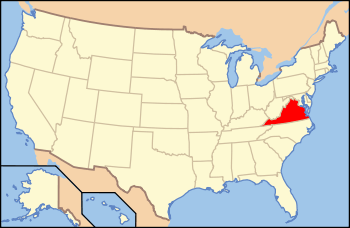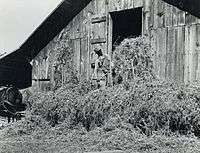Pittsylvania County, Virginia
| Pittsylvania County, Virginia | ||
|---|---|---|
|
Pittsylvania County Courthouse | ||
| ||
 Location in the U.S. state of Virginia | ||
 Virginia's location in the U.S. | ||
| Founded | 1767 | |
| Named for | William Pitt | |
| Seat | Chatham | |
| Largest town | Hurt | |
| Area | ||
| • Total | 978 sq mi (2,533 km2) | |
| • Land | 969 sq mi (2,510 km2) | |
| • Water | 9 sq mi (23 km2), 0.9% | |
| Population (est.) | ||
| • (2015) | 62,194 | |
| • Density | 64/sq mi (25/km²) | |
| Congressional district | 5th | |
| Time zone | Eastern: UTC-5/-4 | |
| Website |
www | |
Pittsylvania County is a county located in the Commonwealth of Virginia. As of the 2010 census, the population was 63,506.[1] Its county seat is Chatham.[2]
Pittsylvania County is included in the Danville, VA Micropolitan Statistical Area.[3]
The largest undeveloped uranium deposit in the United States — and the seventh largest in the world — is located in Pittsylvania County.[4] (See Uranium mining in Virginia)
History

Originally "Pittsylvania" was a name suggested for an unrealized British colony located primarily in what is now West Virginia. Pittsylvania County would not have been within this proposed colony, subsequently known as Vandalia.
The county was formed in 1767 from Halifax County. It was named for William Pitt, 1st Earl of Chatham, who served as Prime Minister of Great Britain from 1766 to 1768 and opposed harsh colonial policies.
In 1777 the western part of Pittsylvania County became Patrick Henry County.
Maud Clement's History of Pittsylvania County notes the following: ”Despite the settlers’ intentions, towns failed to develop for two reasons: the generally low level of economic activity in the area and the competition from plantation settlements already providing the kind of marketing and purchasing services typically offered by a town. Plantation settlements along the rivers, particularly at ferrying points, became commercial centers. The most important for early Pittsylvania was that of Sam Pannill, a Scots-Irishman, who at the end of the eighteenth century, while still a young man, set up a plantation town at Green Hill on the north side of the Staunton River in Campbell. (Clement 15)”
Its economy was tobacco-dominated and reliant on a growing slave labor force. It was a county without towns or a commercial center. Plantation villages on the major River thoroughfares were the only centers of trade, until the Danville emergence. (Clement 23)”
The city of Danville’s history up through the antebellum period overall is an expression of the relationship between the town and the planters who influenced its development.
Geography

According to the U.S. Census Bureau, the county has a total area of 978 square miles (2,530 km2), of which 969 square miles (2,510 km2) is land and 9 square miles (23 km2) (0.9%) is water.[5] It is the largest county in Virginia by land area and second-largest by total area. The county is bounded on the north by the Roanoke River, intersected by the Banister River through the middle, and drained by the Dan River on the south.[6]
Districts
The county is divided into seven districts: Banister, Callands-Gretna, Chatham-Blairs, Dan River, Staunton River, Tunstall, and Westover.
Adjacent counties and cities
- Bedford County, Virginia - northwest
- Campbell County, Virginia - northeast
- Halifax County, Virginia - east
- Caswell County, North Carolina - southeast
- Danville, Virginia - south
- Rockingham County, North Carolina - southwest
- Henry County, Virginia - west/southwest
- Franklin County, Virginia - west/northwest
Major highways
Demographics
| Historical population | |||
|---|---|---|---|
| Census | Pop. | %± | |
| 1790 | 11,579 | — | |
| 1800 | 12,697 | 9.7% | |
| 1810 | 17,172 | 35.2% | |
| 1820 | 21,323 | 24.2% | |
| 1830 | 26,034 | 22.1% | |
| 1840 | 26,398 | 1.4% | |
| 1850 | 28,796 | 9.1% | |
| 1860 | 32,104 | 11.5% | |
| 1870 | 31,343 | −2.4% | |
| 1880 | 52,589 | 67.8% | |
| 1890 | 59,941 | 14.0% | |
| 1900 | 46,894 | −21.8% | |
| 1910 | 50,709 | 8.1% | |
| 1920 | 56,493 | 11.4% | |
| 1930 | 61,424 | 8.7% | |
| 1940 | 61,697 | 0.4% | |
| 1950 | 66,096 | 7.1% | |
| 1960 | 58,296 | −11.8% | |
| 1970 | 58,789 | 0.8% | |
| 1980 | 66,147 | 12.5% | |
| 1990 | 55,655 | −15.9% | |
| 2000 | 61,745 | 10.9% | |
| 2010 | 63,506 | 2.9% | |
| Est. 2015 | 62,194 | [7] | −2.1% |
| U.S. Decennial Census[8] 1790-1960[9] 1900-1990[10] 1990-2000[11] 2010-2013[1] | |||
As of the census[12] of 2000, there were 61,745 people, 24,684 households, and 18,216 families residing in the county. The population density was 64 people per square mile (25/km²). There were 28,011 housing units at an average density of 29 per square mile (11/km²). The racial makeup of the county was 75.00% White, 23.66% Black or African American, 0.14% Native American, 0.19% Asian, 0.37% from other races, and 0.63% from two or more races. 1.23% of the population were Hispanic or Latino of any race.
There were 24,684 households out of which 30.40% had children under the age of 18 living with them, 58.30% were married couples living together, 11.70% had a female householder with no husband present, and 26.20% were non-families. 23.40% of all households were made up of individuals and 9.80% had someone living alone who was 65 years of age or older. The average household size was 2.49 and the average family size was 2.93.
In the county, the population was spread out with 23.00% under the age of 18, 7.20% from 18 to 24, 28.80% from 25 to 44, 26.60% from 45 to 64, and 14.30% who were 65 years of age or older. The median age was 40 years. For every 100 females there were 95.40 males. For every 100 females age 18 and over, there were 92.90 males.
The median income for a household in the county was $35,153, and the median income for a family was $41,175. Males had a median income of $30,105 versus $21,382 for females. The per capita income for the county was $16,991. About 8.60% of families and 11.80% of the population were below the poverty line, including 14.80% of those under age 18 and 16.60% of those age 65 or over.
Government
Pittsylvania County is governed by an elected seven-member Board of Supervisors. Management of the County is vested in a Board-appointed County Administrator.
| Name | Party | First Election | District | |
|---|---|---|---|---|
| Jessie Barksdale (Chair) | Dem | 2011 | Banister | |
| Elton Blackstock (Vice-Chair) | Ind | 2014 | Staunton River | |
| Tim Barber | Ind | 2003 | Tunstall | |
| Jerry Hagerman | Ind | 2011 | Callands-Gretna | |
| Joe Davis | Rep | 2015 | Dan River | |
| Ronald Scearce | Ind | 2015 | Westover | |
| Bob Warren | Rep | 2015 | Chatham-Blairs | |
There are also five elected Constitutional Officers:
- Clerk of the Circuit Court: Mark Scarce (I)
- Commonwealth's Attorney: Bryan Haskins (R)
- Sheriff: Mike Taylor (I)
- Commissioner of Revenue: Shirley Yeatts Hammock (I)
- Treasurer: Vincent Shorter (I)
Communities
Towns
Unincorporated communities
|
|
See also
- List of Virginia counties
- National Register of Historic Places listings in Pittsylvania County, Virginia
- Uranium mining in the USA, Virginia
References
- 1 2 "State & County QuickFacts". United States Census Bureau. Retrieved January 4, 2014.
- ↑ "Find a County". National Association of Counties. Retrieved 2011-06-07.
- ↑ "Revised Delineations of Metropolitan Statistical Areas, Micropolitan Statistical Areas, and Combined Statistical Areas, and Guidance on Uses of the Delineations of These Areas" (PDF). Office Of Management and Budget. February 28, 2013. Retrieved February 8, 2015.
- ↑ Shulz, Max (2008, July 26). Virginia Is Sitting on the Energy Mother Lode. The Wall Street Journal. Accessed 27 July 2008.
- ↑ "US Gazetteer files: 2010, 2000, and 1990". United States Census Bureau. 2011-02-12. Retrieved 2011-04-23.
- ↑
 Ripley, George; Dana, Charles A., eds. (1879). "Pittsylvania". The American Cyclopædia.
Ripley, George; Dana, Charles A., eds. (1879). "Pittsylvania". The American Cyclopædia.
- ↑ "County Totals Dataset: Population, Population Change and Estimated Components of Population Change: April 1, 2010 to July 1, 2015". Retrieved July 2, 2016.
- ↑ "U.S. Decennial Census". United States Census Bureau. Retrieved January 4, 2014.
- ↑ "Historical Census Browser". University of Virginia Library. Retrieved January 4, 2014.
- ↑ "Population of Counties by Decennial Census: 1900 to 1990". United States Census Bureau. Retrieved January 4, 2014.
- ↑ "Census 2000 PHC-T-4. Ranking Tables for Counties: 1990 and 2000" (PDF). United States Census Bureau. Retrieved January 4, 2014.
- ↑ "American FactFinder". United States Census Bureau. Retrieved 2011-05-14.
- ↑ http://www.pittsylvaniacountyva.gov/218/Board-of-Supervisors
External links
 |
Franklin County | Bedford County | Campbell County |  |
| Henry County | |
Halifax County | ||
| ||||
| | ||||
| Rockingham County, North Carolina | City of Danville | Caswell County, North Carolina |
Coordinates: 36°49′N 79°24′W / 36.82°N 79.40°W
_(2).jpg)
